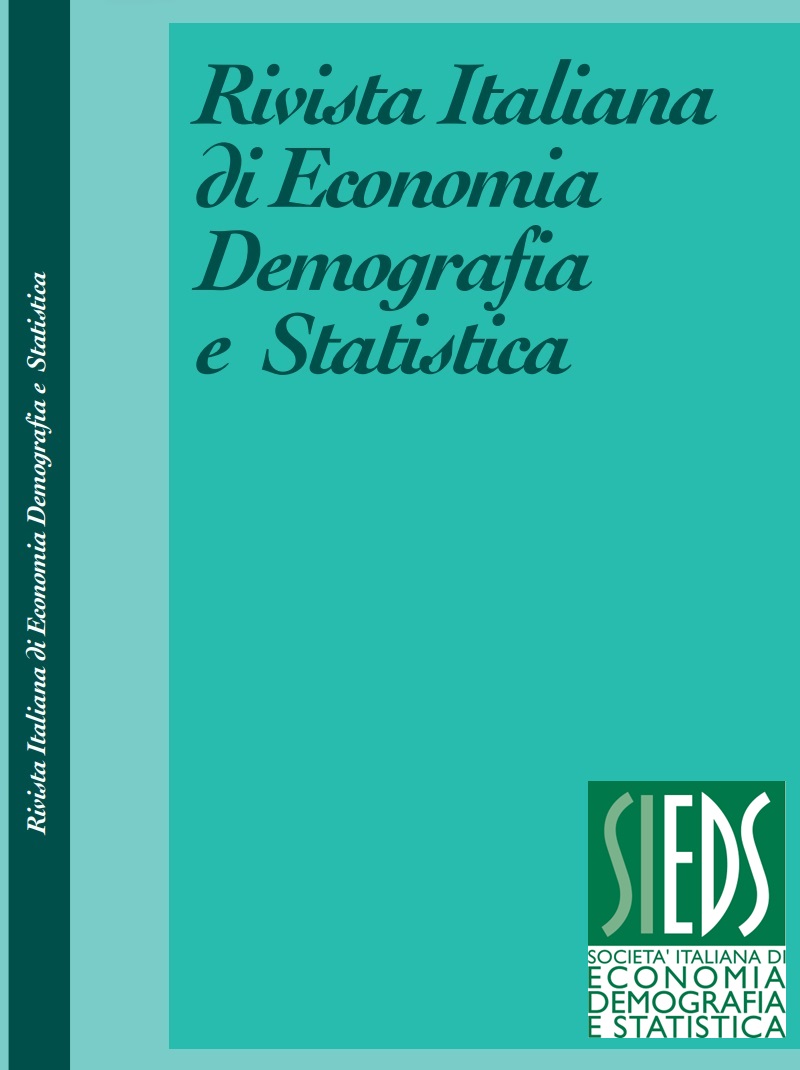Health, well-being and quality of life satisfaction: gender differences in Italian regions
DOI:
https://doi.org/10.71014/sieds.v79i4.341Keywords:
Gender discrimination, Composite index, Health, territorial inequalities, well-being, satisfactionAbstract
Gender differences are an inherent part of human existence. However, beyond biological disparities, social structures have historically established gender-based roles, distinct societal functions, and varying social status across genders. The gender gap affects everyone: our families, communities, workplaces, societies and this influenced women health, well-being and quality of life. The EU has made significant progress in terms of gender equality in recent decades. A European-level tool that monitors disparities between men and women in different member countries is the Gender Equality Index, developed by the European Institute for Gender Equality (EIGE) in 2013. Starting from the analysis proposed by EIGE, the aim of this work is to represent gender differences in Italian regions in 3 domains: Health, Well-being and Quality of life. Using a multisource approach, simple indicators, both objective and subjective, were chosen for each domain. A total of 14 indicators were calculated, starting from Multipurpose survey on households “Aspects of daily life”, Life tables and Multipurpose Survey: time use (all by Istat). The analyses were carried out with a model based on the use of multivariate analysis techniques and the construction of synthetic indices, one for each domain, capable of providing an overall view, which cannot be obtained by considering individual elements separately. The results show for Quality life satisfaction and Health a gap in favour of men, except for some territorial differences; instead, women reveal a better lifestyle, so the results of Well-being domain are to the advantage of them.
References
BERICAT E. 2012. The European Gender Equality Index: Conceptual and Analytical Issues, Social Indicators Research, Vol. 108, pp. 1–28. https://doi.org/10.1007/s11205-011-9872-z DOI: https://doi.org/10.1007/s11205-011-9872-z
BLANCHFLOWER D. G., BRYSON A. 2024. The female happiness paradox. Journal of Population Economic, Vol. 37, No. 16. https://doi.org/10.1007/s00148-024-00981-5 DOI: https://doi.org/10.1007/s00148-024-00981-5
CASCELLA C., WILLIAMS J., PAMPAKA M. 2022. An Extended Regional Gender Gaps Index (eRGGI): Comparative Measurement of Gender Equality at Different Levels of Regionality. Social Indicators Research,Vol. 159, pp. 757–800. https://doi.org/10.1007/s11205-021-02764-x DOI: https://doi.org/10.1007/s11205-021-02764-x
DI BELLA E., FACHELLI S., LÓPEZ-ROLDÁN P., SUTER C. 2023. Measuring Gender Equality. Social Indicators Research Series, Vol 87. Springer, Cham. https://doi.org/10.1007/978-3-031-41486-2_1 DOI: https://doi.org/10.1007/978-3-031-41486-2
EUROPEAN COMMISSION. 2020. Communication from the commission to the European parliament, the council, the European economic and social committee and the committee of the regions A Union of Equality: Gender Equality Strategy 2020-2025 Brussels, 5.3.2020 COM152 final (2020).
EUROPEAN INSTITUTE FOR GENDER EQUALITY. 2023. Gender Equality Index 2023- Country Profiles: Italy. ISSN: 2600-1780MH-AG-23-012-EN-N
FUSCO D., LIGUORI M.A., PAGLIUCA M.M. 2023. Gender gap of Italian region: a synthetic index propoposal. Rivista Italiana di Economia Demografia e Statistica Volume LXXVII No.4 Ottobre-Dicembre 2023.
KLASEN S. 2006. UNDP’s gender-related measures: Some conceptual problems and possible solutions, Journal of Human Development and Capabilities, Vol. 7, No. 2, pp. 243–274. DOI: https://doi.org/10.1080/14649880600768595
LAYARD P. R. G. 2011. Happiness: Lessons from a new science. London: Penguin.
https://doi.org/10.1080/14733140600986227 DOI: https://doi.org/10.1080/14733140600986227
MAZZIOTTA M., PARETO A. 2016. On a generalized non-compensatory composite index for measuring socio-economic phenomena, Social Indicators Research, Vol. 127, pp. 983–1003. DOI: https://doi.org/10.1007/s11205-015-0998-2
PERMANYER I. 2010. The measurement of multidimensional gender inequality: Continuing the debate. Social Indicators Research, Vol. 95, pp. 181–198. DOI: https://doi.org/10.1007/s11205-009-9463-4
WORLD HEALTH ORGANISATION. 2016. Women’s health and well-being in Europe: beyond the mortality advantage. ISBN 978 92 890 5191 0
Downloads
Published
Issue
Section
License
Copyright (c) 2025 Daniela Fusco, Paola Giordano, Maria Antonietta Liguori, Margherita Maria Pagliuca

This work is licensed under a Creative Commons Attribution 4.0 International License.



